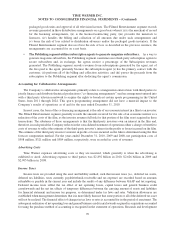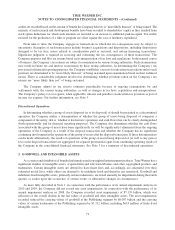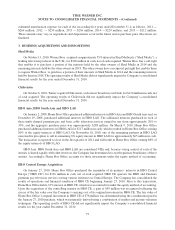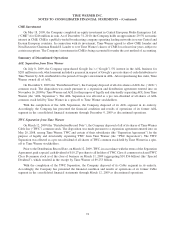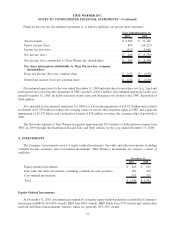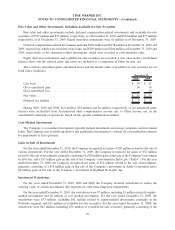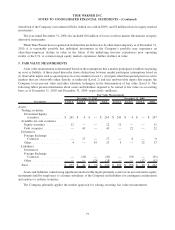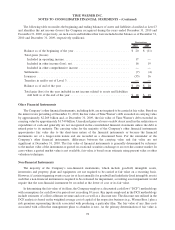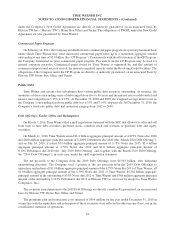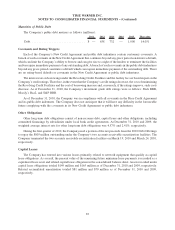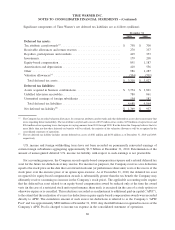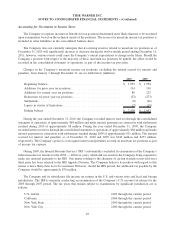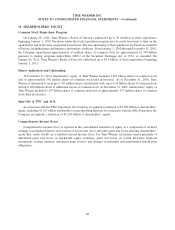Time Magazine 2010 Annual Report Download - page 91
Download and view the complete annual report
Please find page 91 of the 2010 Time Magazine annual report below. You can navigate through the pages in the report by either clicking on the pages listed below, or by using the keyword search tool below to find specific information within the annual report.
determined using a DCF model, the resulting fair value is considered a Level 3 measurement. During the year ended
December 31, 2010, certain film costs, which were recorded as inventory in the consolidated balance sheet, were
written down to $81 million from their carrying value of $168 million. During the year ended December 31, 2009,
certain film costs, which were recorded as inventory in the consolidated balance sheet, were written down to
$271 million from their carrying value of $431 million.
6. INVENTORIES AND FILM COSTS
Inventories and film costs consist of (millions):
December 31, 2010 December 31, 2009
Inventories:
Programming costs, less amortization ................. $ 3,441 $ 3,269
DVDs, books, paper and other merchandise ............. 360 332
Total inventories . .................................. 3,801 3,601
Less: current portion of inventory ...................... (1,920) (1,769)
Total noncurrent inventories .......................... 1,881 1,832
Film costs — Theatrical:
(a)
Released, less amortization ......................... 655 575
Completed and not released ......................... 166 282
In production . .................................. 1,379 1,228
Development and pre-production ..................... 98 157
Film costs — Television:
(a)
Released, less amortization ......................... 929 779
Completed and not released ......................... 300 482
In production . .................................. 571 413
Development and pre-production ..................... 6 6
Total film costs. . .................................. 4,104 3,922
Total noncurrent inventories and film costs ............... $ 5,985 $ 5,754
(a)
Does not include $1.498 billion and $1.764 billion of net film library costs as of December 31, 2010 and December 31, 2009, respectively,
which are included in intangible assets subject to amortization in the consolidated balance sheet.
Approximately 89% of unamortized film costs for released theatrical and television product are expected to be
amortized within three years from December 31, 2010. In addition, approximately $1.4 billion of the film costs of
released and completed and not released theatrical and television product are expected to be amortized during the
twelve-month period ending December 31, 2011.
7. DERIVATIVE INSTRUMENTS
Time Warner uses derivative instruments, principally forward contracts, to manage the risk associated with the
volatility of future cash flows denominated in foreign currencies and changes in fair value resulting from changes in
foreign currency exchange rates. The principal currencies being hedged include the British Pound, Euro, Australian
Dollar and Canadian Dollar. Time Warner uses foreign exchange contracts that generally have maturities of three to
18 months to hedge various foreign exchange exposures, including the following: (i) variability in foreign-currency-
denominated cash flows, such as the hedges of unremitted or forecasted royalty and license fees owed to Time
Warner domestic companies for the sale or anticipated sale of U.S. copyrighted products abroad or cash flows for
certain film production costs denominated in a foreign currency (i.e., cash flow hedges) and (ii) currency risk
79
TIME WARNER INC.
NOTES TO CONSOLIDATED FINANCIAL STATEMENTS – (Continued)



